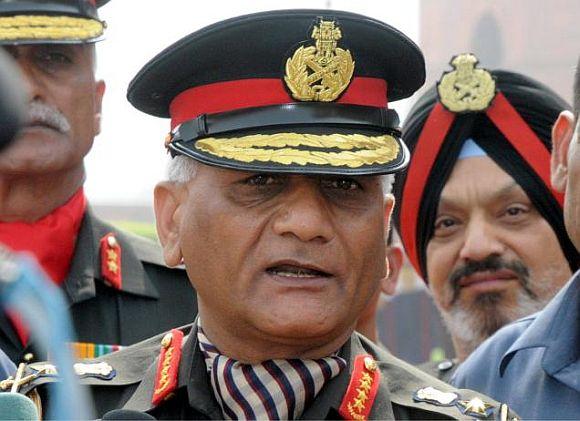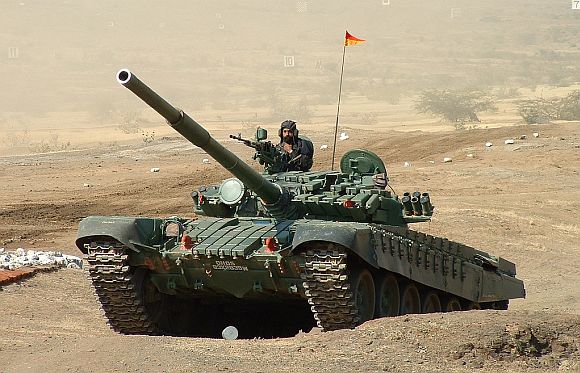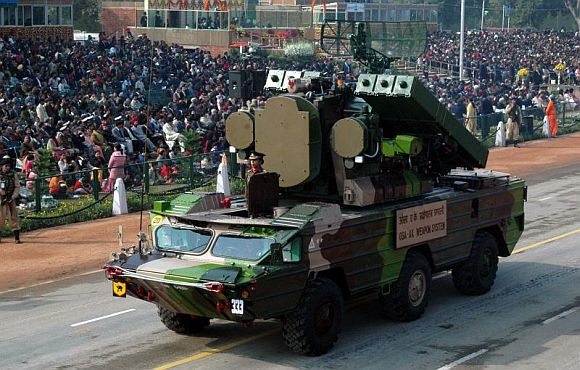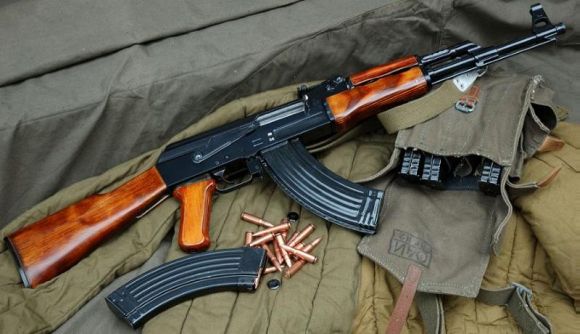
The revelation last week that Army Chief Gen V K Singh had written to Prime Minister Manmohan Singh, telling him essentially that the army was unfit for war should have surprised nobody.
Last month, General V K Singh had written in to the defence minister in far greater detail.
In January 2010, then army chief, General Deepak Kapoor, had announced that 80 per cent of his tanks were night blind, which in other words admits that they were unfit for war. And when the use of force was considered after the 26/11 Mumbai terror strikes, all three service chiefs sent to the defence minister a laundry list of equipment deficiencies.
Besides this, a slew of media reports over the preceding decade have highlighted deficiencies in the mechanised forces; artillery; the air defence network; the infantry and Special Forces being key among them.
Systematic military intelligence analysis, of the kind that is routine in Rawalpindi and Beijing, would leave Pakistan and China with no doubts about India's military weakness. But the Indian public might miss the broader picture.
...

Tank fleet
Designed to deter Pakistan from sponsoring terror strikes inside India by posing a threat to retaliate with a deep offensive into that country, the tank fleet remains near night blind.
While the 800-odd T-90S tanks in service, as well as the 124 Arjun tanks can fight at night, India's 2400-odd T-72 tanks, a 1960s Soviet design, are mostly night blind, and are comprehensively outclassed by Pakistan's T-80UD tanks.
The planned purchase of add-on night sights for the T-72 had dragged on fruitlessly. Even if it is implemented, it would hardly make up for the badly outdated T-72 design.
The army chief's letter to the PM also drew attention to the deficiency in armour piercing tank ammunition, with depots holding vast quantities of training ammunition that is incapable of penetrating an actual tank.
In any high-intensity war, ammunition shortages would bring the strike corps to a grinding halt well before the attainment of its objectives.
Click on NEXT to go further...

Artillery
For a century, the most crucial arm on the battle, in terms of casualties caused on the enemy has been the artillery.
India's 220-odd artillery regiments (there are 18 guns in a regiment) field equipment that is at least a quarter of a century old since there has been no artillery procurement since 1987. As a result, the army uses a mix of many kinds of different guns, a logistical nightmare in terms of maintenance support and ammunition handling.
The process of inducting new artillery will take at least five years, and is complicated by the MoD's blacklisting of almost every major international arms vendor.
The Artillery Rationalisation Plan proposes to acquire 3,000-3,600 155mm, 45 calibre ultralight and 155 mm 52 calibre towed, mounted and self-propelled guns in the next decade for about 180 of its 220 artillery regiments. But there is no movement for now.
...

Air defence
Pakistan's inability to detect the incursion by the US Special Forces team that killed Osama bin Laden made that country seem militarily inept. Similarly, India's porous air defence network could lead to national embarrassment.
The radar network, which must provide seamless and layered coverage across the length of the border, has huge holes, and the development and production of new radars by Bharat Electronics Limited has lagged badly.
India's air defence guns are today 40-50 years old. The L-70 and ZU-23 guns are from the 1960s and 1970s, while programmes to upgrade them by mating them to modern radars have still to be implemented.
Missile systems like the SAM-2 Pichora are repeatedly given life extensions, even as they remain obviously incapable of bringing down a modern, high-performance fighter.
The situation is even worse for the mechanised forces' mobile air defence, equipped with Russian platforms like the ZSU-23 Schillka and the OSA-AK (SAM-8) that date back to the 1970s.
In the last financial year, the MoD has signed Rs 17,000 crore worth of procurement contracts for air defence artillery. But Rs 13,000 crore of that is for just two squadrons of indigenous Akash missiles, which will be deployed in the northeast. Many of the big holes remain unplugged for now.
...

Special forces
Even as the army takes pride in the capabilities of its special forces, many of these units still engage in counter-insurgency operations with the venerable AK-47 assault rifle, perhaps the only special forces in the world that carry such outdated equipment.
Equally worrisome is their night vision capability, a key concern since special forces operate mainly at night.
Another key capability that lags is man-portable communications.
...

Infantry
The Indian Army's 350-odd infantry battalions, respected worldwide for their discipline and commitment, are amongst the most neglected arms. This is ironical, given that most army chiefs have been infantrymen.
Most infantrymen say that the infantry's primary weapons, the 5.62 mm INSAS rifle and light machine gun, which the Ordnance Factory Board fabricates, have not met the standards of a modern army.
Even more worrisome is the infantry's night-fighting capabilities. Most of the 30,000 night vision devices which Bharat Electronics Ltd had been asked to build remain undelivered.
Short range radio communications remain another dire weakness. Senior officers admit that Pakistani terrorists who infiltrate into J&K often carry better NVDs and radio sets than the army jawans who combat them.
However, a sense of realisation appears to be dawning on the MoD and there is a concerted attempt to modify procurement procedures and structures in order to fill these glaring gaps in defence capability. But, given that the average procurement contract takes six to seven years from conception to delivery, many of these gaps will continue for now.
Click on NEXT to go further...